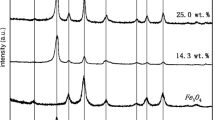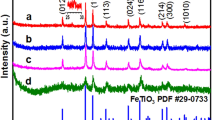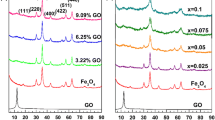Abstract
A new method for the degradation of bisphenol A (BPA) in aqueous solution was developed. The oxidative degradation characteristics of BPA in a heterogeneous Fenton reaction catalyzed by Fe3O4/graphite oxide (GO) were studied. Transmission electron microscopic images showed that the Fe3O4 nanoparticles were evenly distributed and were ∼6 nm in diameter. Experimental results suggested that BPA conversion was affected by several factors, such as the loading amount of Fe3O4/GO, pH, and initial H2O2 concentration. In the system with 1.0 g L−1 of Fe3O4/GO and 20 mmol L−1 of H2O2, almost 90 % of BPA (20 mg L−1) was degraded within 6 h at pH 6.0. Based on the degradation products identified by GC–MS, the degradation pathways of BPA were proposed. In addition, the reused catalyst Fe3O4/GO still retained its catalytic activity after three cycles, indicating that Fe3O4/GO had good stability and reusability. These results demonstrated that the heterogeneous Fenton reaction catalyzed by Fe3O4/GO is a promising advanced oxidation technology for the treatment of wastewater containing BPA.











Similar content being viewed by others
References
Aliyan H, Fazaeli R, Jalilian R (2013) Fe3O4@ mesoporous SBA-15: a magnetically recoverable catalyst for photodegradation of malachite green. Appl Surf Sci 276:147–153
Arnold SM, Hickey WJ, Harris RF (1995) Degradation of atrazine by Fenton’s reagent: condition optimization and product quantification. Environ Sci Technol 29:2083–2089
Chou S, Huang C (1999) Application of a supported iron oxyhydroxide catalyst in oxidation of benzoic acid by hydrogen peroxide. Chemosphere 38:2719–2731
Costa RC, Lelis M, Oliveira L, Fabris J, Ardisson J, Rios R, Silva C, Lago R (2006) Novel active heterogeneous Fenton system based on Fe3-xMxO4 (Fe, Co, Mn, Ni): the role of M2+ species on the reactivity towards H2O2 reactions. J Hazard Mater 129:171–178
De Laat J, Gallard H (1999) Catalytic decomposition of hydrogen peroxide by Fe(III) in homogeneous aqueous solution: mechanism and kinetic modeling. Environ Sci Technol 33:2726–2732
Feng J, Hu X, Yue PL, Zhu HY, Lu GQ (2003) Discoloration and mineralization of Reactive Red HE-3B by heterogeneous photo-Fenton reaction. Water Res 37:3776–3784
Gültekin I, Ince NH (2007) Synthetic endocrine disruptors in the environment and water remediation by advanced oxidation processes. J Environ Manag 85:816–832
Guo C, Ge M, Liu L, Gao G, Feng Y, Wang Y (2009) Directed synthesis of mesoporous TiO2 microspheres: catalysts and their photocatalysis for bisphenol A degradation. Environ Sci Technol 44:419–425
Hong P, Zeng Y (2002) Degradation of pentachlorophenol by ozonation and biodegradability of intermediates. Water Res 36:4243–4254
Hu X, Liu B, Deng Y, Chen H, Luo S, Sun C, Yang P, Yang S (2011) Adsorption and heterogeneous Fenton degradation of 17α-methyltestosterone on nano Fe3O4/MWCNTs in aqueous solution. Appl Catal B Environ 107:274–283
Huang R, Fang Z, Yan X, Cheng W (2012) Heterogeneous sono-Fenton catalytic degradation of bisphenol A by Fe3O4 magnetic nanoparticles under neutral condition. Chem Eng J 197:242–249
Hummers WS Jr, Offeman RE (1958) Preparation of graphitic oxide. J Am Chem Soc 80:1339–1339
Ioan I, Wilson S, Lundanes E, Neculai A (2007) Comparison of Fenton and sono-Fenton bisphenol A degradation. J Hazard Mater 142:559–563
Kim J-H, Park P-K, Lee C-H, Kwon H-H, Lee S (2008) A novel hybrid system for the removal of endocrine disrupting chemicals: nanofiltration and homogeneous catalytic oxidation. J Membr Sci 312:66–75
Klečka GM, Staples CA, Clark KE, van der Hoeven N, Thomas DE, Hentges SG (2009) Exposure analysis of bisphenol A in surface water systems in North America and Europe. Environ Sci Technol 43:6145–6150
Kong S-H, Watts RJ, Choi J-H (1998) Treatment of petroleum-contaminated soils using iron mineral catalyzed hydrogen peroxide. Chemosphere 37:1473–1482
Kwan WP, Voelker BM (2002) Decomposition of hydrogen peroxide and organic compounds in the presence of dissolved iron and ferrihydrite. Environ Sci Technol 36:1467–1476
Kwan WP, Voelker BM (2003) Rates of hydroxyl radical generation and organic compound oxidation in mineral-catalyzed Fenton-like systems. Environ Sci Technol 37:1150–1158
Liao C, Kannan K (2011) High levels of bisphenol A in paper currencies from several countries, and implications for dermal exposure. Environ Sci Technol 45:6761–6768
Lin S-S, Gurol MD (1998) Catalytic decomposition of hydrogen peroxide on iron oxide: kinetics, mechanism, and implications. Environ Sci Technol 32:1417–1423
Luo W, Zhu L, Wang N, Tang H, Cao M, She Y (2010) Efficient removal of organic pollutants with magnetic nanoscaled BiFeO3 as a reusable heterogeneous Fenton-like catalyst. Environ Sci Technol 44:1786–1791
Malik P (2004) Oxidation of safranine T in aqueous solution using Fenton’s reagent: involvement of an Fe(III) chelate in the catalytic hydrogen peroxide oxidation of safranine T. J Phys Chem A 108:2675–2681
Mohapatra D, Brar S, Tyagi R, Surampalli R (2011) Concomitant degradation of bisphenol A during ultrasonication and Fenton oxidation and production of biofertilizer from wastewater sludge. Ultrason Sonochem 18:1018–1027
Navalon S, Alvaro M, Garcia H (2010) Heterogeneous Fenton catalysts based on clays, silicas and zeolites. Appl Catal B Environ 99:1–26
Neyens E, Baeyens J (2003) A review of classic Fenton’s peroxidation as an advanced oxidation technique. J Hazard Mater 98:33–50
Nguyen TD, Phan NH, Do MH, Ngo KT (2011) Magnetic Fe2MO4 (M: Fe, Mn) activated carbons: fabrication, characterization and heterogeneous Fenton oxidation of methyl orange. J Hazard Mater 185:653–661
Noonan GO, Ackerman LK, Begley TH (2011) Concentration of bisphenol A in highly consumed canned foods on the US market. J Agric Food Chem 59:7178–7185
Oehlmann J, Oetken M, Schulte-Oehlmann U (2008) A critical evaluation of the environmental risk assessment for plasticizers in the freshwater environment in Europe, with special emphasis on bisphenol A and endocrine disruption. Environ Res 108:140–149
Ortiz de la Plata GB, Alfano OM, Cassano AE (2010) Decomposition of 2-chlorophenol employing goethite as Fenton catalyst II: reaction kinetics of the heterogeneous Fenton and photo-Fenton mechanisms. Appl Catal B Environ 95:14–25
Pan B, Xing B (2008) Adsorption mechanisms of organic chemicals on carbon nanotubes. Environ Sci Technol 42:9005–9013
Perez M, Torrades F, Domenech X, Peral J (2002) Fenton and photo-Fenton oxidation of textile effluents. Water Res 36:2703–2710
Staples CA, Dome PB, Klecka GM, Oblock ST, Harris LR (1998) A review of the environmental fate, effects, and exposures of bisphenol A. Chemosphere 36:2149–2173
Stieber M, Putschew A, Jekel M (2011) Treatment of pharmaceuticals and diagnostic agents using zero-valent iron–Kinetic studies and assessment of transformation products assay. Environ Sci Technol 45:4944–4950
Vandenberg LN, Maffini MV, Sonnenschein C, Rubin BS, Soto AM (2009) Bisphenol-A and the great divide: a review of controversies in the field of endocrine disruption. Endocr Rev 30:75–95
Wu C, Liu X, Wei D, Fan J, Wang L (2001) Photosonochemical degradation of phenol in water. Water Res 35:3927–3933
Xue X, Hanna K, Abdelmoula M, Deng N (2009) Adsorption and oxidation of PCP on the surface of magnetite: kinetic experiments and spectroscopic investigations. Appl Catal B Environ 89:432–440
Yang X, Tian P-F, Zhang C, Xu J, Deng Y-Q, Gong J, Han Y-F (2013) Au/carbon as Fenton-like catalysts for the oxidative degradation of bisphenol A. Appl Catal B Environ 134:145–152
Yang Z-P, Gong X-Y, Zhang C-J (2010) Recyclable Fe3O4/hydroxyapatite composite nanoparticles for photocatalytic applications. Chem Eng J 165:117–121
Zhao Y, Hu H (2008) Photo-Fenton degradation of 17 beta-estradiol in presence of alpha-FeOOHR and H2O2. Appl Catal B Environ 78:250–258
Acknowledgments
We are grateful for the grants from the National Natural Science Foundation of China (Grant no. 51308183, 51379060), Natural Science Foundation of Jiangsu Province of China (Grant no. BK20130828), Special Fund of Specialized Research Fund for the Doctoral Program of Higher Education (20130094120009), National Key Technologies R&D Program of China (2012BAB03B04), and Major Science and Technology Program for Water Pollution Control and Treatment (2012ZX07103-005).
Author information
Authors and Affiliations
Corresponding author
Additional information
Responsible editor: Philippe Garrigues
Rights and permissions
About this article
Cite this article
Hua, Z., Ma, W., Bai, X. et al. Heterogeneous Fenton degradation of bisphenol A catalyzed by efficient adsorptive Fe3O4/GO nanocomposites. Environ Sci Pollut Res 21, 7737–7745 (2014). https://doi.org/10.1007/s11356-014-2728-8
Received:
Accepted:
Published:
Issue Date:
DOI: https://doi.org/10.1007/s11356-014-2728-8




